Photo
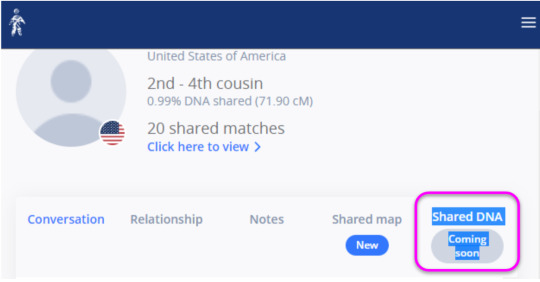
Coming soon! When?
2 notes
·
View notes
Text
youtube
We need a chromosome browser at AncestryDNA!
Andy makes some incredibly strong points in this video and he makes them very well. It's a huge step in the right direction. I hope he's willing to go further with it. He has one foot on "a chromosome browser isn't needed most of the time…it is not used for the vast majority of your genealogy questions" and the other foot on "chromosome browsers are essential…we need a chromosome browser." I know it's dangerous to take a stand that will rub people at Ancestry the wrong way but if we're going to get a chromosome browser at AncestryDNA, we can't vacillate.
#genetic genealogy#genealogy#triangulation#dna#visual phasing#dna testing#ancestry.com#ancestrydna#ancestry#DNA segment triangulation.#Youtube
1 note
·
View note
Text
Triangulating at 23andMe
After you sign in to 23andMe go to the left side of the page and follow the link to DNA relatives:

Select a relative of interest. I chose Patricia, a new “3rd cousin” match:
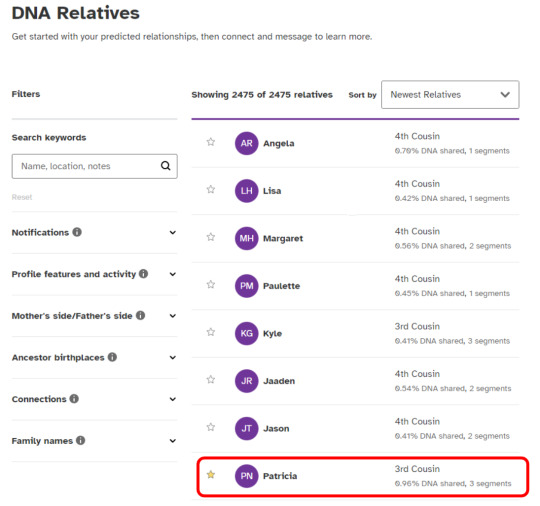
After you click or tap on the relative of interest, scroll down to “Find Relatives in Common.” Click or tap on the blue button:
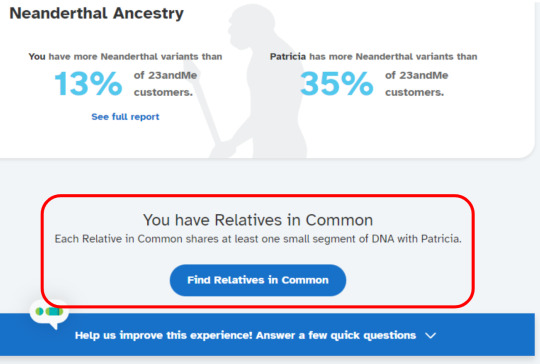
Review the list of “Relatives in Common.” In this case, these are people who share DNA with me AND Patricia (shared matches). If there is “DNA Overlap” (neon green box) the shared match triangulates with me and Patricia. The work of triangulation is already done for me!

After the closest family members, the top relative in common who triangulates is a paternal first cousin once removed, Cousin “c”:

Additional triangulation along with some google searches and a message to Patricia confirm that Patricia is related to me through my paternal grandfather and now we know exactly how we are related!
4 notes
·
View notes
Photo

There’s abundant evidence that triangulating a small segment confirms that it is a valid segment.
3 notes
·
View notes
Text
Can a 6 cM connection be meaningful?
When it comes to small DNA segments, we’ve heard the “glass half empty” version of the story many times. Here’s the other side of that story.
Submitted for your consideration: A pair of third cousins twice removed and their 6 cM connection…
According to AncestryDNA, Bryan Smith and his cousin, K, share 6 cM of DNA across 1 segment. And according to Ancestry’s ThruLines, Bryan and Cousin K share a pair of third great grandparents, Reuben Willis Smith and his wife Mary Connell.

The cM value is certainly consistent with the identified relationship but did Bryan and Cousin K inherit their shared DNA from the Smith ancestry as shown? Is the 6 cM segment even valid or could it be an artifact of an imperfect DNA matching algorithm?
Let’s start with an easy evaluation: the shared match list.
Among Bryan and K’s list of shared matches at AncestryDNA:
HG, a descendant of Reuben and Mary’s son, Charles Thomas Smith (HG shares 57 cM with Bryan)
RR, a descendant of Reuben and Mary’s daughter, Fannie Janes Smith (RR shares 47 cM with Bryan and 38 cM with K)
IG, another descendant of Reuben and Mary’s son, Charles Thomas Smith (IG shares 47 cM with Bryan and 71 cM with K)
And at least three other descendants of Reuben and Mary are on the shared match list.
So we’re off to a promising start. In addition to the fact that Bryan and K share DNA and a paper trail leading to Ruben and Mary, this group of matches gives us more evidence suggesting that Bryan and K might be related as suspected.
But what about that 6 cM segment shared by Bryan and K? Is it valid? Did it come from the shared Smith ancestors or did it originate elsewhere?
To get the most comprehensive help in answering these questions, we turn to GEDmatch. As indicated in the ThruLine image above, both Bryan and his father are related to DNA Cousin K through their Smith line. And because K is on GEDmatch, we can see that Bryan and his father both share DNA with K on a specific portion of Chromosome 12:

Further investigation reveals that two other descendants of Reuben and Mary, Cousins I and G, share DNA with Bryan and his father on Chromosome 12 in roughly the same location. In fact, all of the matches in question match each other on Chromosome 12:
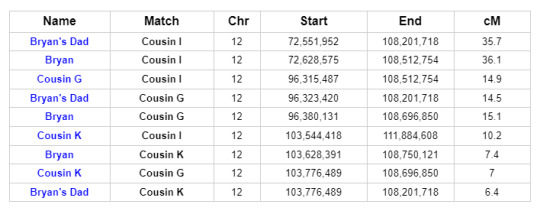
This is what we call a Triangulation Group. It brings the possible genetic connections into sharper focus.
The common segment shared by all of the members of this Triangulation Group indicates that they all share a common ancestor. And we’ve already identified shared ancestry through the Smith line. Cousins I and G are first cousins once removed and they are descendants of Reuben and Mary’s son Charles Thomas Smith...
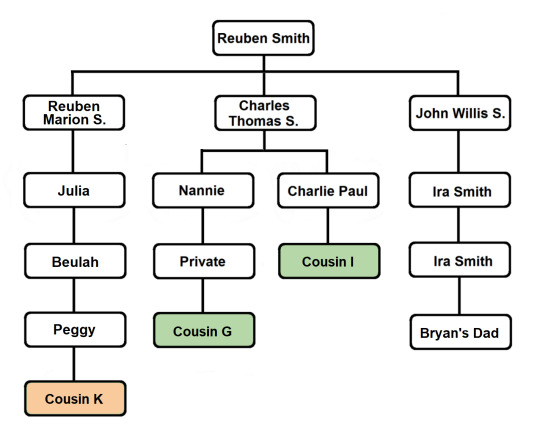
A review of the pedigrees of the matches in question reveals no lines of shared ancestry other than the known shared Smith line. This investigation is summarized briefly in the table below, listing 2nd great grandparent surnames and shared ancestors (blue for paternal names and surnames, light red for maternal names and surnames):
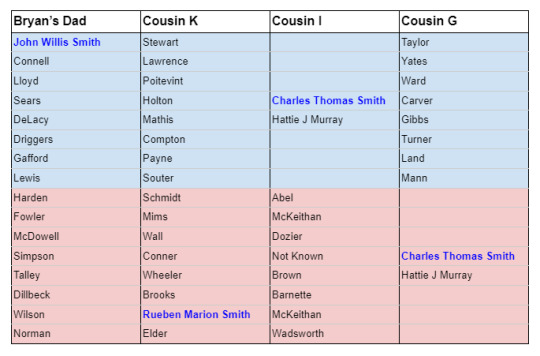
Although we cannot say with perfect certainty that there is no additional common ancestry that conceivably could account for the shared segment of DNA on Chromosome 12, the known evidence doesn’t leave room for much doubt.
For completeness, here’s a chart summarizing the amount of DNA shared by the relatives in question:

And cluster analysis for Cousin G yields a cluster with eight descendants of Reuben Willis Smith, including Bryan Smith and Cousin K:

Not everyone will feel the need to go this far to investigate a 6 cM connection. But this post provides examples of ways to investigate the validity of an ordinary small segment and to determine whether the shared DNA legitimately belongs with the presumed paper trail source of the DNA.
Discussion
Skepticism regarding small segments of shared DNA is appropriate. In comparison to larger shared segments, such segments are more likely to be IBS (false). Additionally, even when small segments can be shown to be reliable, we have to grapple with the fact that small segments can be too old to fall within the reach of reliable historical documentation.
With the exponential growth of the DNA matching databases, the impetus to explore distant matches waned. Reluctance to do the strenuous work involved in using small segments grew. With access to strong genetic connections leading back to target ancestors, why bother with low cM connections?
The sentiment is understandable!
On the other hand, I believe that excessive skepticism has impeded progress in genetic genealogy. As databases have grown, our opportunities for research have multiplied and our research techniques have improved. But at the same time, goalposts for small segment success have been moved to poorly-defined and very unreasonable points.
[From the skeptics: Your success with a small segment doesn’t count if you find a larger segment in a relative! I don’t want to hear about triangulation! Visual phasing is not allowed!]
If we applied such arbitrary restrictions to all areas of genealogy, we’d struggle to get our work done!
Even with our luxuriously large DNA databases, distant genetic connections are the only connections available in some areas of investigation (or to people who hail from less heavily-tested populations). Defeatist refusal to accept low cM matches as evidence in genetic genealogy needlessly limits our potential.
Don’t get me wrong, I’m fully in favor of scholarly rigor. But let’s not allow skepticism to pave the way for denialism!
When distant genetic connections are found to be of dubious quality, they should be set aside. But shared segments should not be judged on the basis of size alone. Even the most fervent opponents of small-segment research will admit that small segments are often valid (IBD). And while these opponents frequently cite IBD/IBS percentages, they ironically fail to see that our ability to find these percentages points directly to a practical method for sorting distant matches on an individual basis.
We are privileged to have access to enormous databases of incredibly valuable genetic information. More than a statistical hiccup that can lead us serendipitously to more reliable information, small DNA segments are messages we carry with us every day, testifying to our connections with our ancestors. Genetic information, even in small amounts, can be just as valuable as any other form of information. We should be good stewards of that information and we should invest good faith effort in understanding how our distant matches can inform us about our rich ancestral history.
I’ll close with this analogy for small segments:
You want some refreshing water but the glass is only half-full. Drink it or toss it out?

Posted with Bryan Smith’s permission. 17 May 2023
#genetic genealogy#DNA testing#DNA#small segments#visual phasing#Triangulation#dna segment#DNA segment triangulation#DNA clustering#clustering#pedigree#family tree#ThruLines
3 notes
·
View notes
Photo
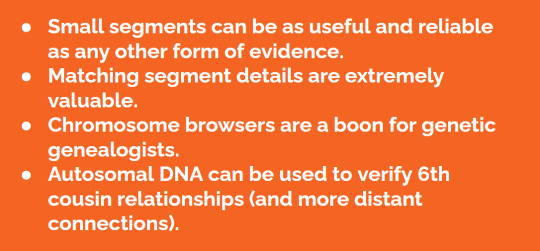
2 notes
·
View notes
Text
Use MyHeritage DNA’s New Genetic Group Filter
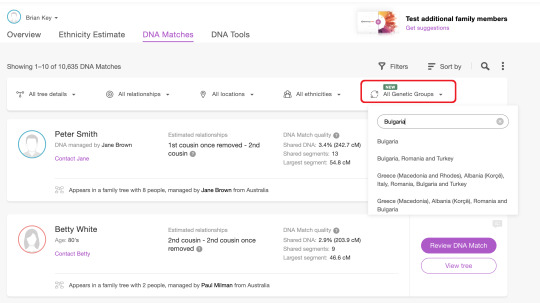
Our genetic genealogy toolbox keeps expanding. MyHeritage has installed a new filtering option on the DNA Matches page, enabling users to filter their DNA Matches to only display genetic relatives who share a specific Genetic Group.
Filtering one’s matches based on Genetic Group membership can help one identify matches who hail from a certain region – a potentially valuable clue for determining relationships. According to MyHeritage, “[y]ou can filter the matches based on the Genetic Groups in your results, or use the search field to search for any of the 2,114 Genetic Groups supported on MyHeritage.”
Let us continue to receive analytic tools that keep finding family fun.
12 notes
·
View notes
Text
Help 23andMe Fix DNA Relatives
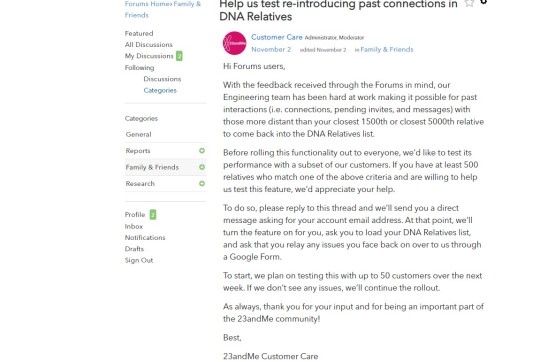
23andMe may reverse their recent DNA Relatives purge. 23andMe’s Customer Care posted a request on November 2, 2020 to the site’s community forum asking users to help 23andMe’s engineers restore “past connections in DNA Relatives,” including “past interactions (i.e. connections, pending invites, and messages) with those more distant than your closest 1500th or closest 5000th relative.” The company now intends to return at least some of the purged matches.
Users can volunteer to beta test “this functionality.”
Just follow these instructions:
1. Log into 23andMe.
2. Reply to the thread from Customer Care in the community forum.
3. Respond to the direct message sent from 23andMe requesting the email address associated with your 23andMe account.
4. Then, 23andMe will turn the feature on for your account.
5. Load DNA Relatives.
6. Communicate (via a Google Form) any and all problems.
Applaud 23andMe for listening to user feedback, for engaging customers, and for recovering functionality for a crucial product feature. Let’s hope 23andMe learned something from this latest kerfuffle. Openness and transparency in product decision-making generate trust. Trust begets loyalty, referrals, brand equity, and a self-perpetuating product. 23andMe stands to gain from collaborating with existing customers to improve and expand the DNA Relatives user experience for all.
Achieving those gains requires more interaction with customers and more restorative product developments. 23andMe ought to discuss this situation in a blog post and post a banner on the DNA Relatives page. 23andMe should have notified all customers of the DNA Relatives service changes prior to their implementation. Such an announcement would have generated enough early negative feedback from customers to justify cancelling the launch, saving 23andMe’s team all the time and effort poured into implementing, troubleshooting, and, now, repealing the misguided product strategy. As of now, 23andMe fails to address this issue anywhere other than on the site’s forum. The customers active on the company’s community forum represent a minute fraction of the site’s user base; that forum remains an insufficient medium for discussing drastic product changes that affect all customers. Now, 23andMe must work to repair the relationship with users, after having disappointed, disrespected, and dismayed their devotees with a desperate power play. Reinstating the DNA Relatives search and filter tools, admitting the company’s error, and offering a sincere apology to customers are the appropriate next steps for controlling 23andMe’s self-inflicted damage.
As genetic genealogists, we must monitor each and every product decision from each and every DNA testing company. We must sound alarms when required. We must ensure that our interests, our investments as paying customers, as avid users, and often as product evangelists, remain properly secured. To survive, leaders in the direct-to-consumer genealogical DNA test industry must learn to engage and satisfy genetic genealogists. Some may call this common sense, but sense is not so common.
6 notes
·
View notes
Video
youtube
If someone tells you that matching segment data and chromosome browsers aren't necessary, tell them about Danny.
2 notes
·
View notes
Video
youtube
Roger Frøysaa‘s Ancestry Autotagger...
SCRIPT:
https://github.com/lrf1/ancestry_scripts/blob/master/ancestry_dnsmatches_grouptagger_v2.js
INSTRUCTIONS:
https://docs.google.com/document/d/100BqYdjeVdwmHaT9gTL3miknxm7bKik4KwcHaoUX72I/edit?
DISCUSSION:
https://www.facebook.com/groups/407494112747727/permalink/1738979356265856/
NOTE: This is a very helpful video but I didn’t make it!
6 notes
·
View notes
Photo

Genetic Fallacy?
5 notes
·
View notes
Text
Why The World Needs GEDMatch
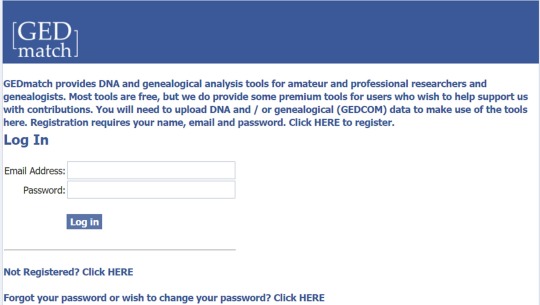
While some genetic genealogists have endured a crisis of confidence, recent events have renewed my dedication to advancing modern society via science and technology.
Law enforcement used GEDMatch, genetic genealogy’s killer app, to help identify a suspect in California’s Golden State Killer case. Investigators converted genetic data from the Golden State Killer crime scenes into a file format compatible with GEDMatch, uploaded the data to the site, found relative matches, collected and interpreted pedigree data, and winnowed the universe of potential suspects down to a single individual. Law enforcement agents then surveilled that individual and collected his discarded DNA. The discarded DNA matched the original crime scene DNA and led to the subsequent arrest of Joseph DeAngelo.
The click bait journalism coverage that followed inspired mass hysteria about genealogical DNA testing. Reporters lusting for the orgasmic thrill of screaming “Fire!” in a crowded theater realized their wet dreams, plying news outlets with shoddy and frenzied reporting to alarm the public. The Golden State Killer coverage – full of speculation, errors, omissions, oversimplifications, misconceptions, and misinformed opinions - drove some family historians to stop using GEDMatch. Knowing what actually happened, I won’t.
As a genetic genealogist, I won’t remove or privatize my GEDMatch kits nor will I discontinue recommending others join the site. I tour the nation lecturing on genetic genealogy, frequently delivering lectures that instruct the audience on maximizing one’s productivity with GEDMatch. I have no plans to discontinue that either.
GEDMatch offers invaluable analytic tools that commercial direct-to-consumer DNA testing outfits lack. In doing so, GEDMatch enables users to reassemble families fractured by historic diaspora and social upheaval across the globe. GEDMatch has facilitated reunions and insights that eluded users of the other genetic genealogy sites. Using GEDMatch, I have demolished centuries of brick walls in family trees to identify enslaved ancestors and the ancestors who enslaved them, sired them, and copulated with them. Using GEDMatch, I have identified the American GI fathers of orphans in Southeast Asia. Using GEDMatch, I have reconnected families separated for 150+ years and split across multiple continents. We need GEDMatch.
In a field increasingly consumed by narcissism and greed, social media mavens (also known as The LOL-OMG-Everybody-Look-at-Me Brigade) now purchase DNA tests as ethnicity calculators, posting admixture results as molecular selfies, “quantified self” content likely to elevate their Klout scores. Some DNA testing companies, blinded by the shine of a new nickel, have implemented marketing strategies that position DNA tests as the 21st century mood ring: a means to a new version of you or the punchline to a bad joke. Outfitting their sites with useless gimmicks and kitschy interfaces, some DNA testing companies have too often made the mistake of turning DNA, one of nature’s most powerful tools, into a toy.
GEDMatch, on the other hand, offers a refuge for genealogists seeking to escape the gimmickry and instead wield genealogical DNA tests for their intended purpose: genealogy. GEDMatch recognizes the power of DNA, letting us leverage the strength of the tie that binds us all to illuminate the most intimate moments of human history. GEDMatch emancipates genetics from the Ivory Tower and places digital instruments for parsing genetic information in the hands of citizen scientists. The users’ discoveries (including, ironically, the outcome of the Golden State Killer investigation) provide significant societal benefits, bringing resolution and reconciliation to countless individuals, families, and communities.
The Golden State Killer case raises several ethical issues. GEDMatch wasn’t designed for law enforcement searches, even if they don’t constitute an obvious breach of the site’s terms of service. GEDMatch users didn’t explicitly consent to participate in those types of endeavors. I neither condone nor support law enforcement officials or their civilian agents using GEDMatch in their investigations. Some genetic genealogists may applaud colleagues for performing this type of forensic genealogy, but the Machiavellian approach to engaging GEDMatch in law enforcement collaborations failed to consider the implications for GEDMatch or the site’s 900,000+ users. Whatever one’s stance, these ethical concerns require rational and deliberative discussions followed by appropriate action, not viral panic and paranoia.
We should support and celebrate GEDMatch as an incomparable genetic genealogy sandbox and avoid endangering this humanitarian resource. I hope that most realize GEDMatch’s value and will continue connecting families across the planet.
33 notes
·
View notes

